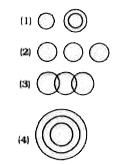Taking satability as the factor, which one of the following represents correct relationship
InI3>InI
AlCl>AlCl3
Tll>Tll3
TlCl3>TlCl
To solve the question regarding the stability of oxidation states in the elements of the boron family, we will analyze the oxidation states of indium, aluminum, and thallium, and their stability based on the inert pair effect.
1. Identify the Elements and Their Oxidation States:
- The elements in the boron family are Boron (B), Aluminum (Al), Gallium (Ga), Indium (In), and Thallium (Tl).
- We are given the oxidation states:
- Indium: +1 and +3
- Aluminum: +1 and +3
- Thallium: +1 and +3
2. Understand the Inert Pair Effect:
- The inert pair effect refers to the tendency of the outermost s-electrons to remain non-ionized or inert as we move down a group in the periodic table.
- As we go down the group from Aluminum to Thallium, the stability of the lower oxidation state (+1) increases due to the inert pair effect.
3. Analyze the Stability of Oxidation States:
- For Aluminum (Al), the +3 oxidation state is more stable than +1.
- For Indium (In), the +3 oxidation state is still stable, but the +1 state starts to gain stability.
- For Thallium (Tl), the +1 oxidation state becomes significantly more stable compared to the +3 state due to the inert pair effect.
4. Determine the Correct Relationship:
- Based on the analysis, the correct relationship in terms of stability of oxidation states is:
- Thallium (+1) > Indium (+1) > Aluminum (+1)
- Therefore, the correct option representing stability is the one where the lower oxidation states are more stable as we move down the group.
5. Conclusion:
- The correct answer is that the lower oxidation states become more stable as we move down the group in the boron family, specifically indicating that Thallium in the +1 state is the most stable.
Final Answer:
The correct relationship based on stability is: Thallium (+1) > Indium (+1) > Aluminum (+1).
---
- The elements in the boron family are Boron (B), Aluminum (Al), Gallium (Ga), Indium (In), and Thallium (Tl).
- We are given the oxidation states:
- Indium: +1 and +3
- Aluminum: +1 and +3
- Thallium: +1 and +3
- The inert pair effect refers to the tendency of the outermost s-electrons to remain non-ionized or inert as we move down a group in the periodic table.
- As we go down the group from Aluminum to Thallium, the stability of the lower oxidation state (+1) increases due to the inert pair effect.
- For Aluminum (Al), the +3 oxidation state is more stable than +1.
- For Indium (In), the +3 oxidation state is still stable, but the +1 state starts to gain stability.
- For Thallium (Tl), the +1 oxidation state becomes significantly more stable compared to the +3 state due to the inert pair effect.
- Based on the analysis, the correct relationship in terms of stability of oxidation states is:
- Thallium (+1) > Indium (+1) > Aluminum (+1)
- Therefore, the correct option representing stability is the one where the lower oxidation states are more stable as we move down the group.
- The correct answer is that the lower oxidation states become more stable as we move down the group in the boron family, specifically indicating that Thallium in the +1 state is the most stable.
The correct relationship based on stability is: Thallium (+1) > Indium (+1) > Aluminum (+1).
Topper's Solved these Questions
Similar Questions
In each of the following questions, which one of the following diagrams represents the correct relationship among .
Lion, Fox and Carnivorous

View SolutionIn each of the following questions, which one of the following diagrams represents the correct relationship among .
Manager, Labour Union and Worker

View Solution
Knowledge Check
Which of the following pair does not show correct relationship ?
AB.O.=12(Nb−Na)BB.O.∝1Bond lengthCB.O.∝1Bond dissociation energyDNb>Na,B.O.=+veWhich one of the following represent correct food chain ?
ATree → Crow → TigerBDeer → Jackal → TigerCZooplankton → FishDGrass → Grasshopper → Frog → SnakeWhich of the following is the correct relationship?
 AI & II are funtional isomers.BII & IV are metamers.CI & IV are position isomers.DI & III are chain isomers.
AI & II are funtional isomers.BII & IV are metamers.CI & IV are position isomers.DI & III are chain isomers.
Which of the following is not the correct relationship?

View SolutionWhich of the following pairs represents a parasitic relationship?
View SolutionWhich of the following pairs represents a parasitic relationship?
View SolutionWhich one of the following relationship is correct ?
View SolutionWhich one of the following relationship is correct?
View Solution
